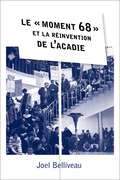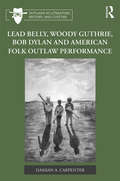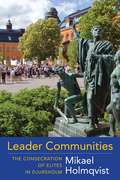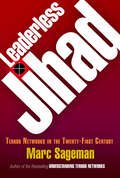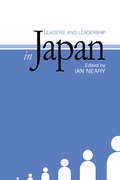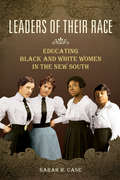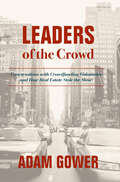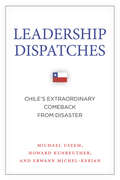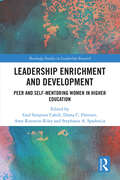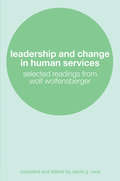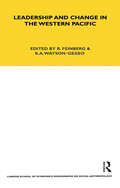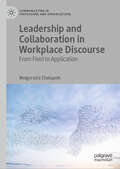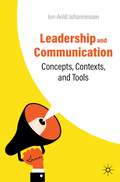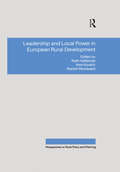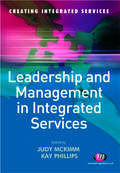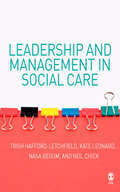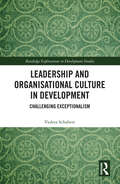- Table View
- List View
Le « moment 68 » et la réinvention de l’Acadie: Le « moment 68 » et la réinvention de l’Acadie (Amérique française)
by Joel BelliveauLa distance et les barrières linguistiques n’ont pu empêcher le mouvement étudiant nord-américain de former une incarnation locale en terre acadienne, culminant dans une participation enthousiasme au « moment 1968 » planétaire, avec une saveur originale toutefois, qui changera profondément la culture politique de cette minorité linguistique.|Quatre notables acadiens reçus tels des chefs d’État par Charles de Gaulle au palais de l’Élysée. Plus de 2000 personnes qui manifestent dans les rues de Moncton scandant « on veut du français ! ». Une confrontation très médiatisée à l’hôtel de ville entre quatre jeunes résolus et un maire francophobe. Une tête de cochon déposée sur le seuil de sa maison en guise de protestation. L’occupation du plus grand pavillon de l’Université de Moncton par des étudiants armés de boyaux d’arrosage. Voilà quelques images fortes du « moment 68 » en Acadie, des images ancrées profondément dans la mémoire collective des Acadiens.Le présent ouvrage relate l’histoire du mouvement étudiant de Moncton, qui a été, toutes proportions gardées, l’un des plus importants au Canada au cours des années 1960. La dimension nationaliste de ce mouvement étant déjà relativement bien connue, cet ouvrage, appuyé sur des sources inexploitées, apporte une contribution importante à nos connaissances du « moment 68 », en l’ancrant dans l’histoire de la nouvelle gauche. Il permet ainsi de mieux comprendre la genèse et la nature de ce mouvement qui a conduit à un changement de paradigme politique en Acadie. Car, comme nous le rappelle l’auteur, les actions et les paroles des étudiants acadiens représentent, aussi, une incarnation locale de ce large mouvement qui marque l’histoire contemporaine et qui secoue le Québec comme le Canada, les États-Unis et l’Europe.|Quatre notables acadiens reçus tels des chefs d’État par Charles de Gaulle au palais de l’Élysée. Plus de 2000 personnes qui manifestent dans les rues de Moncton scandant « on veut du français ! ». Une confrontation très médiatisée à l’hôtel de ville entre quatre jeunes résolus et un maire francophobe. Une tête de cochon déposée sur le seuil de sa maison en guise de protestation. L’occupation du plus grand pavillon de l’Université de Moncton par des étudiants armés de boyaux d’arrosage. Voilà quelques images fortes du « moment 68 » en Acadie, des images ancrées profondément dans la mémoire collective des Acadiens.Le présent ouvrage relate l’histoire du mouvement étudiant de Moncton, qui a été, toutes proportions gardées, l’un des plus importants au Canada au cours des années 1960. La dimension nationaliste de ce mouvement étant déjà relativement bien connue, cet ouvrage, appuyé sur des sources inexploitées, apporte une contribution importante à nos connaissances du « moment 68 », en l’ancrant dans l’histoire de la nouvelle gauche. Il permet ainsi de mieux comprendre la genèse et la nature de ce mouvement qui a conduit à un changement de paradigme politique en Acadie. Car, comme nous le rappelle l’auteur, les actions et les paroles des étudiants acadiens représentent, aussi, une incarnation locale de ce large mouvement qui marque l’histoire contemporaine et qui secoue le Québec comme le Canada, les États-Unis et l’Europe. Publié en français
Lead Belly, Woody Guthrie, Bob Dylan, and American Folk Outlaw Performance (Outlaws in Literature, History, and Culture)
by Damian A. CarpenterWith its appeal predicated upon what civilized society rejects, there has always been something hidden in plain sight when it comes to the outlaw figure as cultural myth. Damian A. Carpenter traverses the unsettled outlaw territory that is simultaneously a part of and apart from settled American society by examining outlaw myth, performance, and perception over time. Since the late nineteenth century, the outlaw voice has been most prominent in folk performance, the result being a cultural persona invested in an outlaw tradition that conflates the historic, folkloric, and social in a cultural act. Focusing on the works and guises of Lead Belly, Woody Guthrie, and Bob Dylan, Carpenter goes beyond the outlaw figure’s heroic associations and expands on its historical (Jesse James, Billy the Kid), folk (John Henry, Stagolee), and social (tramps, hoboes) forms. He argues that all three performers represent a culturally disruptive force, whether it be the bad outlaw that Lead Belly represented to an urban bourgeoisie audience, the good outlaw that Guthrie shaped to reflect the social concerns of marginalized people, or the honest outlaw that Dylan offered audiences who responded to him as a promoter of clear-sighted self-evaluation. As Carpenter shows, the outlaw and the law as located in society are interdependent in terms of definition. His study provides an in-depth look at the outlaw figure’s self-reflexive commentary and critique of both performer and society that reflects the times in which they played their outlaw roles.
Lead in Glassy Materials in Cultural Heritage
by Anne Bouquillon Patrice LehuédéAlthough the development of lead crystal was a major step in the history of glass in the late 17th century, the presence of lead in vitreous matrices (glass and glazes) is much older, dating back to the second millennium BCE. Lead in Glassy Materials in Cultural Heritage traces the history of these skills and also looks at the most recent developments in materials science concerning the role played by lead in the properties of glass, including coloring. It develops an understanding of weathering processes and notions of the durability of leaded glass. It also examines public health issues and current recommended standards for the use of lead in industrial glass. This multidisciplinary book is intended for a wide audience: art and technical historians, museum curators, restorers, materials specialists, manufacturers and engineers.
Leader Communities: The Consecration of Elites in Djursholm
by Mikael HolmqvistAll around the world there are elite suburban communities: Palo Alto, California, and Greenwich, Connecticut, in the U.S.; Paris's Neuilly; and Oxshott outside London. These wealthy suburbs are home to the economic and social elites who work in the world's global cities. Stockholm's suburb Djursholm is one such place. It is full of large houses, winding lanes, and is surrounded by a beautiful landscape. Its residents prize physical fitness, healthy eating, fine art, and education. Despite Sweden's reputation for egalitarianism, Djursholm is representative of global mechanisms of privilege and its perpetuation.Leader Communities is the sociologist Mikael Holmqvist's term for places like Djursholm: the communities where elites choose to live, socialize with other elites, and, most importantly, form families and raise their children into future elites. Such neighborhoods consecrate inhabitants into leaders—that is, they offer their residents a social environment that imbues people with a sense of social and moral elevation. By idealizing their residents, leader communities' allegedly superior lifestyle and character act as a principle of distinction and legitimation. Holmqvist calls this a consecracy—a society that leads by means of its aura, brightness, and radiance, allowing the privileged to pose as a moral vanguard. Leaders are made—not born—by the culture, history, traditions, ceremonies, rituals, and institutions of the place. Based on a comprehensive five-year ethnographic study, this book is a community study of Djursholm in which the author ventures inside the world of the elite to explore the mechanics of social interaction and power. Leader Communities introduces vital new concepts to the study and understanding of contemporary elites and offers a troubling analysis of the moral, social, and political consequences of their aspirations to lead societies.
Leader Symbols and Personality Cult in North Korea: The Leader State (Routledge Advances in Korean Studies)
by Jae-Cheon LimThe legitimacy of the North Korean state is based solely on the leaders’ personal legitimacy, and is maintained by the indoctrination of people with leader symbols and the enactment of leadership cults in daily life. It can thus be dubbed a "leader state". The frequency of leader symbols and the richness and scale of leader-symbol-making in North Korea are simply unrivalled. Furthermore, the personality cults of North Korean leaders are central to people’s daily activity, critically affecting their minds and emotions. Both leader symbols and cult activities are profoundly entrenched in the institutions and daily life, and if separated and cancelled, the North Korean state would be transformed. This book analyses North Korea as a "leader state", focusing on two elements, leader symbols and cult activities. It argues that these elements have been, and continue to be, the backbone of North Korea, shaping North Korean culture. To reveal the "leader state" character, the book specifically examines North Korea’s leadership cults, its use of leader symbols in these cults, and the nature of the symbolism involved. How has the North Korean state developed the cult of the Kim Il Sung family? How does the state use leader symbols to perpetuate this cult? How has the state developed myths and rituals that sustain the cult in daily life? What leader images has state propaganda manufactured? How does the state’s manipulation of leader symbols affect the symbolism that is assigned to the leader’s actions? In answering these questions, this book sheds new light on the strength and resilience of the North Korean state, and shows how it has been able to survive even the most difficult economic period of the mid-1990s. Leader Symbols and Personality Cult in North Korea will be essential reading for students and scholars of North Korea, Korean politics, Asian politics, political sociology and visual politics.
Leaderless Jihad
by Marc SagemanIn the post-September 11 world, Al Qaeda is no longer the central organizing force that aids or authorizes terrorist attacks or recruits terrorists. It is now more a source of inspiration for terrorist acts carried out by independent local groups that have branded themselves with the Al Qaeda name. Building on his previous groundbreaking work on the Al Qaeda network, forensic psychiatrist Marc Sageman has greatly expanded his research to explain how Islamic terrorism emerges and operates in the twenty-first century.In Leaderless Jihad, Sageman rejects the views that place responsibility for terrorism on society or a flawed, predisposed individual. Instead, he argues, the individual, outside influence, and group dynamics come together in a four-step process through which Muslim youth become radicalized. First, traumatic events either experienced personally or learned about indirectly spark moral outrage. Individuals interpret this outrage through a specific ideology, more felt and understood than based on doctrine. Usually in a chat room or other Internet-based venues, adherents share this moral outrage, which resonates with the personal experiences of others. The outrage is acted on by a group, either online or offline.Leaderless Jihad offers a ray of hope. Drawing on historical analogies, Sageman argues that the zeal of jihadism is self-terminating; eventually its followers will turn away from violence as a means of expressing their discontent. The book concludes with Sageman's recommendations for the application of his research to counterterrorism law enforcement efforts.
Leaders Can Help
by Cynthia Swain Tara FunkPeople can be leaders. Some leaders are men. Some leaders are women. Leaders can help.
Leaders and Leadership in Japan
by Ian NearyShows Japan's group-orientated society may have had fewer so-called 'leaders', but has excelled as a society of king-makers. On the other hand, the way leadership is expressed derives from different values and perceptions of hierarchy.
Leaders of Their Race: Educating Black and White Women in the New South (Women, Gender, and Sexuality in American History)
by Sarah H. CaseSecondary level female education played a foundational role in reshaping women's identity in the New South. Sarah H. Case examines the transformative processes involved at two Georgia schools--one in Atlanta for African-American girls and young women, the other in Athens and attended by young white women with elite backgrounds. Focusing on the period between 1880 and 1925, Case's analysis shows how race, gender, sexuality, and region worked within these institutions to shape education. Her comparative approach shines a particular light on how female education embodied the complex ways racial and gender identity functioned at the time. As she shows, the schools cultivated modesty and self-restraint to protect the students. Indeed, concerns about female sexuality and respectability united the schools despite their different student populations. Case also follows the lives of the women as adult teachers, alumnae, and activists who drew on their education to negotiate the New South's economic and social upheavals.
Leaders of the Crowd: Conversations With Crowd Funding Visionaries And How Real Estate Stole The Show
by Adam GowerCrowdfunding is nothing new. In fact, America was built and financed by crowdfunding. But in 1933 Congress passed the Securities Act, which shut the door on this most democratic means of raising capital and spreading wealth. In 2012, enjoying broad bipartisan support, congress threw the doors open again, passing the JOBS Act (Jumpstart Our Business Startups). Its intent was to stimulate growth of small businesses and startups, but an unexpected consequence of the Act was that the biggest beneficiary has been the real estate industry. <p><p> Researching the origins of the JOBS Act, Dr. Adam Gower conducted a series of conversations with the people who lobbied for and wrote the laws that became the Act. What he discovered was that at no time had anyone thought that the real estate industry was a relevant constituency. Perplexed by this disconnect between what had been intended and what had happened, he talked to those who had been the very first real estate people to utilize the JOBS Act. These pioneers, all moving on parallel tracks, seeded the biggest, most transformational change to the real estate industry in history. <p> This book uncovers these conversations with the people who created the laws and those who connected the dots to real estate. It weaves a thread through the labyrinthine processes of government, chronicling how the Act was conceived, formed, and ultimately signed into law, and it reveals how the visionaries who have revolutionized real estate capital formation embarked on their missions to change their industry forever. <p> Learn how the JOBS Act, never expected to benefit real estate, has transformed the industry, changing the way capital is raised and syndications are formed forever and how an unintended consequence is helping almost everyone in America invest in real estate like never before.
Leadership Dispatches: Chile's Extraordinary Comeback from Disaster
by Michael Useem Howard Kunreuther Erwann Michel-KerjanOn February 27, 2010, Chile was rocked by a violent earthquake five hundred times more powerful than the one that hit Haiti just six weeks prior. The Chilean earthquake devastated schools, hospitals, roads, and homes, paralyzing the country for weeks and causing economic damage that was equal to 18 percent of Chile's GDP. This calamity hit just as an incumbent political regime was packing its bags and a new administration was preparing to take office. For most countries, it would have taken years, if not decades, to recover from such an event. Yet, only one year later, Chile's economy had reached a six percent annual growth rate. In Leadership Dispatches, Michael Useem, Howard Kunreuther, and Erwann Michel-Kerjan look at how the nation's leaders-in government, business, religion, academia, and beyond-facilitated Chile's recovery. They attribute Chile's remarkable comeback to a two-part formula consisting of strong national leadership on the one hand, and deeply rooted institutional practices on the other. Coupled with strategic, deliberative thinking, these levers enabled Chile to bounce back quickly and exceed its prior national performance. The authors make the case that the Chilean story contains lessons for a broad range of organizations and governments the world over. Large-scale catastrophes of many kinds-from technological meltdowns to disease pandemics-have been on the rise in recent years. Now is the time to seek ideas and guidance from other leaders who have triumphed in the wake of a disaster. In this vein, Leadership Dispatches is both a remarkable story of resilience and an instructive look at how those with the greatest responsibility for a country, company, or community should lead.
Leadership Enrichment and Development: Peer and Self-Mentoring Women in Higher Education (Routledge Studies in Leadership Research)
by Stephanie A. Spadorcia Gail Simpson Cahill Diana C. Direiter Amy Rutstein-RileyThis book shares the LEAD (Leadership Enrichment and Development) method, a framework for supporting and facilitating leadership identity development for women in higher education. Guided by feminist group processes and relational learning, the chapters in this volume illustrate the impacts of self- and peer mentorship on the authors. Part lived experience, part reflection on scholarship on women’s leadership development, this book has implications for those in leadership development settings across professional sectors and career trajectories, offering strategies, implications, and insights for those developing or seeking to learn about peer mentoring programming for women faculty. Women faculty, leadership development coaches, faculty development leaders, directors of centers for teaching excellence, program leaders focused on girls’ and women’s leader development, and students and scholars interested in women’s leadership development in higher education will find this volume of interest. While LEAD’s context is higher education, the volume offers valuable application to other professional settings where women work, lead, and thrive.
Leadership and Authority in Central Asia: The Ismaili Community in Tajikistan (Central Asia Research Forum)
by Otambek MastibekovThis book explores the unfolding of world history in a remote corner of Central Asia: the region of Badakhshan. The history of this region has commonly been explored through the lens of the major superpowers who competed over its territory in the nineteenth and twentieth centuries, including Britain, Russia, and China. Here, we are offered a comprehensive overview of the history of the Ismaili community in Tajikistan. Leadership and Authority in Central Asia identifies traditional forms of religious authority within the network of religious functionaries at a range of levels and discusses the functions of Ismaili political leaders as they have evolved through time. Skilfully applying an interdisciplinary approach – drawing on historical sources, including unpublished materials, and ethnographic fieldwork data collected through interviews – and a perceptive analysis of political theories of leadership in communist and post-communist societies, this book challenges the ways religious and secular categories have been distinguished in recent scholarship Developing a structural explanation for the survival and evolution of religious and political authorities of Badakhshani Ismailis in times of radical social and political upheaval, this book will be of interest to scholars of Muslim societies, Political Science and Central Asian Studies.
Leadership and Business Ethics (Issues in Business Ethics #60)
by Gabriel FlynnThis book offers new and challenging approaches to business ethics that successfully link theory and practice thereby overcoming lacunae and inadequacies in much of the literature concerning ethics and governance, a theme that recurs with remarkable frequency in the history of business ethics as an academic discipline. This work provides imaginative and innovate proposals for the indispensable coupling of virtue, integrity, and character with global business, finance, and banking. The volume seeks to overcome the marginal status of business ethics in universities, business, and enterprise by demonstrating that virtue ethics is an important step in the direction of an adequate response to the leadership issue. This new edition of a popular work points to new ways of achieving an ever more urgent coalescence of ethics and business. It proposes practical advice and viable suggestions to business people on what is right and wrong in business. The volume makes a vital contribution in the area of education that should serve the ongoing development of top leaders. In the important domain of women in leadership, the volume provides new solutions that break boundaries on the global stage. The work challenges unethical marketing of human images with important implications for citizenship and society. The volume contains creative suggestions for the use of spirituality and human development for the enhancement of business and society. The significantly extended second edition includes an exciting line up of leading academics and practitioners in the audacious hope that something may change for the better in the realms of business and banking.
Leadership and Change in Human Services: Selected Readings from Wolf Wolfensberger
by David G. RaceFor over forty years Wolf Wolfensberger has been a significant figure in the world of human services, especially in the field of learning disability. His work on normalization and citizen advocacy in the late 1960s and early 1970s has been acknowledged by supporters and critics alike to have been fundamental to developments in a number of countries, most notably his adopted country, and the USA, Canada, Australasia, and the UK. His further work in developing the theory of social role valorization, the successor to normalisation, and as a commentator on broader trends in society and their effects on vulnerable people and services for them has ensured his place as a major voice for values and the human worth of all people. Never afraid of controversy, his views have brought him into conflict with institutional vested interests and radical groups alike.In Leadership and Change in Human Services David Race introduces the reader to Wolfensberger's key ideas through a series of extracts, with commentary, from his published work. Throughout the edited selection, the emphasis is on placing Wolfensburger's work in contemporary context and examining its continuing relevance today. Including a comprehensive bibliography of Wolfensburger's written output, this text offers an invaluable source of reference to all those concerned with the recent history of the human services.
Leadership and Change in the Western Pacific: Essays Presented To Sir Raymond Firth On The Occasion Of His Ninetieth Birthday (London School Of Economics Monographs On Social Anthropology Ser. #Vol. 66)
by Richard FeinbergAn ethnographic exploration of the rise of new forms of leadership at community and national levels with islanders are synthesising traditional and Western models.
Leadership and Collaboration in Workplace Discourse: From Field to Application (Communicating in Professions and Organizations)
by Małgorzata ChałupnikThis book presents a comprehensive examination of how leadership and collaboration are discursively performed in professional communication, using real-world data from a UK public sector IT team. Taking an auto-ethnographic approach to workplace talk, the author examines the language involved in the performance of different team-based professional roles, examining how professional identity and relationships are indexed through casual face-to-face talk in an office environment. This investigation of how a group of people come together in an effort to achieve shared workplace goals relates to key debates in the area of professional communication, putting forward new theoretical and methodological frameworks for understanding and analysing how person-orientated aspects of professional communication shape discourses of work. This book appeals to a wide and interdisciplinary audience, including advanced undergraduate and postgraduate students, academics and researchers specialising in applied linguistics broadly, and professional communication in particular, as well as consultants and practitioners working across a wide range of professional sectors.
Leadership and Communication: Concepts, Contexts, and Tools
by Jon-Arild JohannessenManagers and leaders spend a great deal of time on communication; it binds together all the communications in the organisational system. In other words, communication is the glue that impacts on the effectiveness of communication in the entire organization, therefore the style of leadership communication has a profound impact on how the organization works. If too much ‘glue’ is used, the consequence is information overload, which hampers effective communication. If there is too little glue, individuals and entire organizations may find themselves in a pathological state of disorder, with people filling the information vacuum with rumours and gossip. Leadership communication can be involving and participatory, motivating colleagues to be creative and put in as much extra effort as is necessary. Leadership communication can also be power-based and patronizing. Such a style of communication will cause tensions and conflicts within an organization. In this textbook, the author shows how information and communication are parts of a special type of interaction, namely situations in which you want to gain trust or influence people. With a plethora of case examples and practical exercises to get stuck into, this engaging book helps students gain a deeper understanding of the concepts and contexts described in each chapter, such as communication strategies, influencing techniques, communication and values, and communication and trust. The second half of the book offers six personal communication tools, and six personal coaching tools, with assignment to each of the coaching tools. In addition, the book provides 66 exercises to the six personal communication tools. Ideal reading for those taking leadership and communication courses, this textbook takes a practical approach to the key issues in organizational communication that will prepare students for their careers in business.
Leadership and Local Power in European Rural Development (Perspectives on Rural Policy and Planning)
by Imre KováchContemporary processes of economic, social, political and cultural restructuring are having profound impacts on the form and function of rural areas within the countries of the European Union and beyond. Furthermore, rural development policies and programmes at EU and national levels have been critical in shaping the responses of different rural areas across Europe to these wider processes of restructuring. Contrasting empirical studies of ten European countries, this volume provides a comprehensive analysis of the restructuring processes and the various national, regional and local rural development programmes. Adopting a different national perspective in each chapter, it focuses particularly on issues of power and leadership in the evolution and administration of these programmes. Five broad issues are examined in each case: socio-economic changes in rural areas, the administrative context in which rural development and political activities take place, the sociological context, the political control of rural development, and the use of different discourses of rurality in shaping the development process.
Leadership and Management in Integrated Services (Creating Integrated Services Series)
by Judy Mckimm and Kay PhillipsGovernment drivers promote integrated health and social care services for children and adults yet the field is immensely complex, with the involvement of multiple agencies, professionals and other stakeholders. This book will help students and new practitioners make sense of this rapidly changing scene. It provides an overview and introduction to core leadership and management principles, the key management structures and organisations that comprise integrated services. It also considers some of the differences and dilemmas arising from the range of professions and organisations involved in delivering integrated services.
Leadership and Management in Police Organizations
by Professor Matthew J. GiblinBuilt on a foundation of nearly 1,200 references, Leadership and Management in Police Organizations is a highly readable text that shows how organizational theory and behavior can be applied to improve the operations, leadership, and management of law enforcement. Author Matthew J. Giblin emphasizes leadership and management as separate skills in successful police supervisors and executives, illustrating to students how the two skills combine to improve individual and organizational efficacy in policing. Readers will come away with a stronger understanding of why organizational decisions matter and the impact research can have on police departments.
Leadership and Management in Police Organizations
by Professor Matthew J. GiblinBuilt on a foundation of nearly 1,200 references, Leadership and Management in Police Organizations is a highly readable text that shows how organizational theory and behavior can be applied to improve the operations, leadership, and management of law enforcement. Author Matthew J. Giblin emphasizes leadership and management as separate skills in successful police supervisors and executives, illustrating to students how the two skills combine to improve individual and organizational efficacy in policing. Readers will come away with a stronger understanding of why organizational decisions matter and the impact research can have on police departments.
Leadership and Management in Social Care
by Trish Hafford-Letchfield Neil F Chick Kate Leonard Nasa Begum′This is a timely and well crafted text which is to be commended, with strong chapters from knowledgeable and committed authors. A stimulating read and one which will be of considerable use to those with responsibility for leading and managing learning in social care and social work′ - Keith Popple, Professor of Social Work, London South Bank University ′This is a welcome and timely book, which forecasts the growing need for workplace learning. I will be one of the first people to buy it′ - Jan Fook, Professor of Social Work, University of Southampton This core textbook provides an authoritative overview of the leadership and management of learning in social care education and practice. Written in response to recent policy and continuing professional development frameworks, the book provides the underpinning knowledge for candidates following post-qualifying awards for social work in leadership, management and practice education Key features include: " reference to the relevant post-qualifying standards in social work at Higher Specialist and Advanced levels " an interprofessional approach " case studies, activities and points for reflection. Leadership and Management in Social Care will equip readers with the relevant knowledge and skills they need to improve the quality of social care services and their delivery. With an emphasis upon continuing professional development it will become essential reading for students following social work and social care qualifications for continuing professional development. Social care practitioners responsible for staff development and interested in progressing to management roles will also find the book invaluable. Trish Hafford-Letchfield is a senior lecturer at London South Bank University for social work, higher education and leadership and management courses. Kate Leonard is a senior lecturer at LSBU and freelance trainer, assessor and mentor. Nasa Begum has been Principal Advisor for Participation at SCIE since 2003 and is a researcher. Neil Chick is Organisational Learning Manager for a housing association and coach mentor.
Leadership and Nationalism in Azerbaijan: Ali Mardan bey Topchibashov, Founder and Creator (Routledge Studies in the History of Russia and Eastern Europe)
by Jamil HasanliAli Mardan bey Topchibashov was a prominent politician, who played a crucial role in the history of Azerbaijan. One of the most striking personalities in the history of Azerbaijan, the founder of liberal ideas, and the first President of the Republic of Azerbaijan, he led the Muslim faction in the first Russian Duma and the Union of Muslims of Russia and was a central figure of the Caucasian émigrés in Europe. This book analyses and presents the life of the first independent Azerbaijani political leaders. Based on extensive research from archives in Azerbaijan, France, Georgia, Russia (Moscow and Kazan) and the UK, some of which are newly accessible, it traces the political personality of Topchibashov as one of the largest Muslim leaders and founder of the Azerbaijan Republic. At the same time, it offers insights into the history of the formation and creation of the national consciousness of the Russian Muslims and tracks the challenges in the national and religious policy of the Imperial administration of the Soviet Union. The author sheds light on the significant problems of the Russian Empire (nationalities specifically) and global movements such as the post-World War I settlement and the difficulties of the many non-Russian groups that declared independence after the Bolshevik rise of power. Filling a lacuna in modern Azerbaijan history, this book will be of interest to academics working on Russian, Soviet, South Caucasus and Central Asian History, in particular Russian Empire, Muslim nations, and nationalism in Central Asia and the Caucasus.
Leadership and Organisational Culture in Development: Challenging Exceptionalism (Routledge Explorations in Development Studies)
by Violeta SchubertThis book uses organisational theory to explore how power and leadership operate in development organisations in different contexts and at different levels. Culture as a tool for enacting change is of particular importance within organisational and leadership analysis but often limiting. Notions of exceptionalism within the development sector mean that lessons from other organisational contexts are often disregarded or deemed irrelevant. In examining the way that culture operates in organisational and leadership analysis and in development thinking and approaches, the book invites closer attention to modes of organising and leading. The book examines development exceptionalism and the leadership fetishism that it evokes as a panacea for addressing disorder and crisis. The term organisationalism is deployed to capture the endeavours to control and manage, produce and reproduce organisation, and the manifestations, responses and imprints of ‘seeing like an organisation’. The modes and manifestations of organisationalism are especially notable in times of crisis and disorder, accusations of wrongdoings, bad culture and bad leadership. This book makes an important contribution to debates on development exceptionalism and leadership and as such will be of interest to researchers in development studies and management studies and related disciplines across sociology, politics and global governance.
